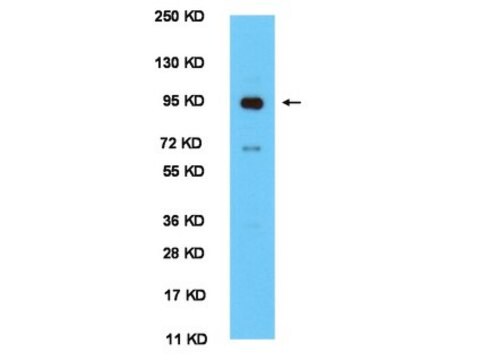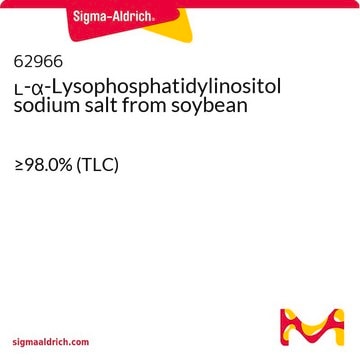L7260
Oleoyl-L-α-lysophosphatidische Säure Natriumsalz
≥98%, solid
Synonym(e):
1-Oleoyl-sn.-glycerin-3-phosphat Natriumsalz
About This Item
Empfohlene Produkte
Assay
≥98%
Form
solid
Farbe
white
Lipid-Typ
phosphoglycerides
Lagertemp.
−20°C
SMILES String
O[C@](COP([O-])(O)=O)([H])COC(CCCCCCC/C=C\CCCCCCCC)=O.[Na+]
InChI
1S/C21H41O7P.Na.H/c1-2-3-4-5-6-7-8-9-10-11-12-13-14-15-16-17-21(23)27-18-20(22)19-28-29(24,25)26;;/h9-10,20,22H,2-8,11-19H2,1H3,(H2,24,25,26);;/b10-9+;;
InChIKey
CHJOEWDRTPWOCY-TTWKNDKESA-N
Suchen Sie nach ähnlichen Produkten? Aufrufen Leitfaden zum Produktvergleich
Verwandte Kategorien
Allgemeine Beschreibung
Anwendung
- for the activation of Ras homolog gene family, member A (RhoA) and expression of claudin-1 in human breast cancer epithelial cell line
- in RH7777 cells for cyclic adenosine monophosphate (cAMP) accumulation assay and calcium mobilisation assay
- in vitro luciferase assay and live-cell imaging
Biochem./physiol. Wirkung
Leistungsmerkmale und Vorteile
Vorsicht
Angaben zur Herstellung
Lagerklassenschlüssel
11 - Combustible Solids
WGK
WGK 3
Flammpunkt (°F)
Not applicable
Flammpunkt (°C)
Not applicable
Persönliche Schutzausrüstung
Eyeshields, Gloves, type N95 (US)
Analysenzertifikate (COA)
Suchen Sie nach Analysenzertifikate (COA), indem Sie die Lot-/Chargennummer des Produkts eingeben. Lot- und Chargennummern sind auf dem Produktetikett hinter den Wörtern ‘Lot’ oder ‘Batch’ (Lot oder Charge) zu finden.
Besitzen Sie dieses Produkt bereits?
In der Dokumentenbibliothek finden Sie die Dokumentation zu den Produkten, die Sie kürzlich erworben haben.
Kunden haben sich ebenfalls angesehen
Artikel
Discover Bioactive Small Molecules for Lipid Signaling Research
Unser Team von Wissenschaftlern verfügt über Erfahrung in allen Forschungsbereichen einschließlich Life Science, Materialwissenschaften, chemischer Synthese, Chromatographie, Analytik und vielen mehr..
Setzen Sie sich mit dem technischen Dienst in Verbindung.











